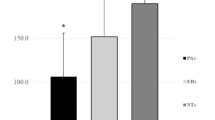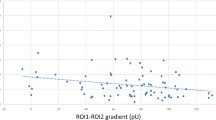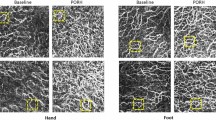Abstract
Skin microcirculation has been proposed as a model of generalized microvascular function. Laser speckle contrast imaging (LSCI) is a novel, noninvasive method to assess skin microvascular function (SMF). To date, SMF data in hypertension are conflicting, and no study with LSCI exists. In addition, the application of LSCI in masked hypertension is scarce. We assessed SMF with LSCI coupled with postocclusive reactive hyperemia (PORH) in patients with newly diagnosed untreated essential hypertension (UHT) and masked hypertension (MH) compared to healthy normotensive (NT) individuals. We enrolled consecutive UHT and MH patients and NT individuals matched for age, sex, body mass index, and smoking status. All participants underwent SMF assessment by LSCI coupled with PORH (PeriCam PSI system, Perimed, Sweden). Correlation analyses were performed between SMF and common cardiovascular risk factors and BP parameters. In total, 70 UHT patients, 20 MH patients and 40 NT individuals were enrolled. UHT and MH patients exhibited significantly impaired SMF compared to NT individuals (UHT patients: base-to-peak flux (p < 0.001)), PORH amplitude (p < 0.001); MH patients: base-to-peak flux (p = 0.013), PORH amplitude (p = 0.022). MH patients did not differ compared to UHT patients. SMF was negatively associated with office, ambulatory and central BP. SMF was negatively associated with blood lipids and smoking. Hypertensive status was the single most important predictor of SMF. UHT and MH patients exhibit impaired SMF compared to NT individuals. MH patients did not differ compared to UHT patients. SMF is negatively associated with BP and cardiovascular risk factors. LSCI could be implemented as a useful tool to investigate SMF in hypertension.
This is a preview of subscription content, access via your institution
Access options
Subscribe to this journal
Receive 12 print issues and online access
$259.00 per year
only $21.58 per issue
Buy this article
- Purchase on Springer Link
- Instant access to full article PDF
Prices may be subject to local taxes which are calculated during checkout


Similar content being viewed by others
References
Feihl F, Liaudet L, Waeber B, Levy BI. Hypertension: a disease of the microcirculation? Hypertension 2006;48:1012–7.
Levy BI, Schiffrin EL, Mourad JJ, Agostini D, Vicaut E, Safaret M, et al. Impaired tissue perfusion a pathology common to hypertension, obesity, and diabetes mellitus. Circulation 2008;118:968–76.
Seliger SL, Salimi S, Pierre V, Giffuni J, Katzel L, Parsa A. Microvascular endothelial dysfunction is associated with albuminuria and CKD in older adults. BMC Nephrol. 2016;17:82.
Yamamoto-Suganuma R, Aso Y. Relationship between post-occlusive forearm skin reactive hyperaemia and vascular disease in patients with Type 2 diabetes—a novel index for detecting micro- and macrovascular dysfunction using laser Doppler flowmetry. Diabet Med. 2009;26:83–8.
Triantafyllou A, Anyfanti P, Zabulis X, Gavriilaki E, Karamaounas P, Gkaliagkousi E, et al. Accumulation of microvascular target organ damage in newly diagnosed hypertensive patients. J Am Soc Hypertens. 2014;8:542–9.
Vuilleumier P, Decosterd D, Maillard M, Burnier M, Hayoz D. Postischemic forearm skin reactive hyperemia is related to cardovascular risk factors in a healthy female population. J Hypertens. 2002;20:1753–7.
Hellmann M, Roustit M, Cracowski JL. Skin microvascular endothelial function as a biomarker in cardiovascular diseases? Pharmacol Rep. Published online 2015.
Holowatz LA, Thompson-torgerson CS, Kenney WL. The human cutaneous circulation as a model of generalized microvascular function. J Appl Physiol. 2008;105:370–2.
Heeman W, Boerma EC, Heeman W, Steenbergen W, Van Dam GM, Boerma EC. Clinical applications of laser speckle contrast imaging: a review. J Biomed Opt. 2019;24:080901.
Mahé G, Humeau-Heurtier A, Durand S, Leftheriotis G, Abraham P. Assessment of skin microvascular function and dysfunction with laser speckle contrast imaging. Circ Cardiovasc Imaging. 2012;5:155–63.
Boas DA, Dunn AK. Laser speckle contrast imaging in biomedical optics. J Biomed Opt. 2010;15:011109.
Humeau-Heurtier A, Abraham P, Durand S, Mahé G. Excellent inter-and intra-observer reproducibility of microvascular tests using laser speckle contrast imaging. Clin Hemorheol Microcirc. 2014;58:439–46.
De Jongh RT, Serné EH, Ijzerman RG, Stehouwer CDA. Microvascular function: a potential link between salt sensitivity, insulin resistance and hypertension. J Hypertens. 2007;25:1887–93.
Kaiser SE, Sanjuliani AF, Estato V, Gomes MB, Tibiriçá E. Antihypertensive treatment improves microvascular rarefaction and reactivity in low-risk hypertensive individuals. Microcirculation 2013;20:703–16.
Serné EH, Gans ROB, Ter Maaten JC, Ter Wee PM, Donker AJM, Stehouwer CDA. Capillary recruitment is impaired in essential hypertension and relates to insulin’s metabolic and vascular actions. Cardiovasc Res. 2001;49:161–8.
Debbabi H, Uzan L, Mourad JJ, Safar M, Levy BI, Tibiriçà E. Increased skin capillary density in treated essential hypertensive patients. Am J Hypertens. 2006;19:477–83.
Gryglewska B, Necki M, Cwynar M, Baron T, Grodzicki T. Neurogenic and myogenic resting skin blood flowmotion in subjects with masked hypertension. J Physiol Pharm. 2010;61:551–8.
Williams B, Mancia G, Spiering W, Agabiti Rosei E, Azizi M, Burnier M, et al. 2018 ESC/ESH Guidelines for the management of arterial hypertension. J Hypertens. 2018;36:1953–2041.
Anyfanti P, Triantafyllidou E, Papadopoulos S, Triantafyllou A, Nikolaidis M, Kyparos A, et al. Smoking before isometric exercise amplifies myocardial stress and dysregulates baroreceptor sensitivity and cerebral oxygenation. J Am Soc Hypertens. 2017;11:376–84.
Roustit M, Cracowski JL. Assessment of endothelial and neurovascular function in human skin microcirculation. Trends Pharm Sci. 2013;34:373–84.
Draijer M, Hondebrink E, Van Leeuwen T, Steenbergen W. Review of laser speckle contrast techniques for visualizing tissue perfusion. Lasers Med Sci. 2009;24:639–51.
Briers JD. Laser Doppler, speckle and related techniques for blood perfusion mapping and imaging. Physiol Meas. 2001;22:35–66.
Senarathna J, Member S, Rege A, Li N, Thakor NV. Laser speckle contrast imaging: theory, instrumentation and applications. IEEE Rev Biomed Eng. 2013;6:99–110.
Bee G, Tee Y, Hanum A, Rahman A, Halim AS. Dependence of human forearm skin postocclusive reactive hyperemia on occlusion time. J Pharm Toxicol Methods. 2004;50:73–78.
Dipla K, Triantafyllou A, Koletsos N, Papadopoulos S, Sachpekidis V, Vrabas I, et al. Impaired muscle oxygenation and elevated exercise blood pressure in hypertensive patients: links with vascular stiffness. Hypertension 2017;70:444–51.
Rosenberry R, Nelson MD. Reactive hyperemia: a review of methods, mechanisms, and considerations. Am J Physiol - Regul Integr Comp Physiol. 2020;318:R605–R618.
IJzerman RG, de Jongh RT, Beijk MAM, van Weissenbruch MM, Delemarre-van de Waal HA, Serné EH, Stehouwer. CDA. Individuals at increased coronary heart disease risk are characterized by an impaired microvascular function in skin. Eur J Clin Invest. 2003;31:536–42.
Aine Q, Uzzaman S, Pfenninger D, Chakrabarti A, Kacirotti N, Rubenfire M, et al. Altered cutaneous microvascular responses to reactive hyperaemia in coronary artery disease: a comparative study with conduit vessel responses. Clin Sci. 2002;103:267–73.
Rossi M, Matteucci E, Pesce M, Consani C, Franzoni F, Santoro G, et al. Peripheral microvascular dysfunction as an independent predictor of atherosclerotic damage in type 1 diabetes patients: a preliminary study. Clin Hemorheol Microcirc. 2013;54:381–91.
Cordovil I, Huguenin G, Rosa G, Bello A, Köhler O, Moraeset de R, et al. Evaluation of systemic microvascular endothelial function using laser speckle contrast imaging. Microvasc Res. 2012;83:376–9.
Triantafyllou A, Doumas M, Anyfanti P, Gkaliagkousi E, Zabulis X, Petidis K, et al. Divergent retinal vascular abnormalities in normotensive persons and patients with never-treated, masked, white coat hypertension. Am J Hypertens. 2013;26:318–25.
Ramoshaba NE, Huisman HW, Lammertyn L, Kotliar KE, Schutte AE, Smith W. Retinal microvasculature and masked hypertension in young adults: the African-PREDICT study. Hypertens Res. 2020;43:1231–8.
Anyfanti P, Gkaliagkousi E, Triantafyllou A, Dipla K, Zarifis H, Arseniou P, et al. Noninvasive assessment of myocardial perfusion in different blood pressure phenotypes and its association with arterial stiffness indices. Am J Hypertens. 2019;32:557–63.
Serné EH, Gans ROB, Ter Maaten JC, Tangelder GJ, Donker AJM, Stehouwer CDA. Impaired skin capillary recruitment in essential hypertension is caused by both functional and structural capillary rarefaction. Hypertension 2001;38:238–42.
Prasad A, Dunnill GS, Mortimer PS, Macgregor GA. Capillary rarefaction in the forearm skin in essential hypertension. J Hypertens. 1995;13:265–8.
Caliskan M, Caliskan Z, Gullu H, Keles N, Bulur S, Turan Y, et al. Increased morning blood pressure surge and coronary microvascular dysfunction in patient with early stage hypertension. J Am Soc Hypertens. 2014;8:652–9.
Henskens LHG, Van Oostenbrugge RJ, Kroon AA, De Leeuw PW, Lodder J. Brain microbleeds are associated with ambulatory blood pressure levels in a hypertensive population. Hypertension 2008;51:62–68.
Wei FF, Zhang ZY, Thijs L, Yang WY, Jacobs L, Cauwenberghs N, et al. Conventional and ambulatory blood pressure as predictors of retinal arteriolar narrowing. Hypertension 2016;68:511–20.
Hashimoto J. Central hemodynamics and target organ damage in hypertension. Tohoku J Exp Med. 2014;233:1–8.
Hashimoto J, Ito S. Central pulse pressure and aortic stiffness determine renal hemodynamics: pathophysiological implication for microalbuminuria in hypertension. Hypertension 2011;58:839–46.
Ott C, Raff U, Harazny JM, Michelson G, Schmieder RE. Central pulse pressure is an independent determinant of vascular remodeling in the retinal circulation. Hypertension 2013;61:1340–5.
Pellaton C, Kubli S, Feihl F, Waeber B. Blunted vasodilatory responses in the cutaneous microcirculation of cigarette smokers. Am Heart J. 2002;144:269–74.
Binggeli C, Spieker LE, Corti R, Sudano I, Stojanovic V, Hayoz D, et al. Statins enhance postischemic hyperemia in the skin circulation of hypercholesterolemic patients: a monitoring test of endothelial dysfunction for clinical practice? J Am Coll Cardiol. 2003;42:71–77.
Štulc T, Kasalová Z, Prázný M, Vrablík M, Škrha J, Češka R. Microvascular reactivity in patients with hypercholesterolemia: effect of lipid lowering treatment. Physiol Res. 2003;52:439–45.
Roustit M, Cracowski J. Non-invasive assessment of skin microvascular function in humans: an insight into methods. Microcirculation 2011;19:47–64.
Cracowski JL, Roustit M. Human skin microcirculation. Compr Physiol. 2020;10:1105–54.
Thompson OB, Andrews MK. Tissue perfusion measurements: multiple-exposure laser speckle analysis generates laser Doppler–like spectra. J Biomed Opt. 2010;15:027015.
Tew GA, Klonizakis M, Crank H, Briers JD, Hodges GJ. Comparison of laser speckle contrast imaging with laser Doppler for assessing microvascular function. Microvasc Res. 2011;82:326–32.
Millet C, Roustit M, Blaise S, Cracowski JL. Comparison between laser speckle contrast imaging and laser Doppler imaging to assess skin blood flow in humans. Microvasc Res. 2011;82:147–51.
Author information
Authors and Affiliations
Corresponding author
Ethics declarations
Conflict of interest
The authors declare no competing interests.
Additional information
Publisher’s note Springer Nature remains neutral with regard to jurisdictional claims in published maps and institutional affiliations.
Supplementary information
Rights and permissions
About this article
Cite this article
Lazaridis, A., Triantafyllou, A., Dipla, K. et al. Skin microvascular function, as assessed with laser speckle contrast imaging, is impaired in untreated essential and masked hypertension. Hypertens Res 45, 445–454 (2022). https://doi.org/10.1038/s41440-021-00816-w
Received:
Revised:
Accepted:
Published:
Issue Date:
DOI: https://doi.org/10.1038/s41440-021-00816-w
Keywords
This article is cited by
-
In vivo mapping of hemodynamic responses mediated by tubuloglomerular feedback in hypertensive kidneys
Scientific Reports (2023)
-
Clinical Significance of Altered Vascular Morphology and Function in Normotension
Current Hypertension Reports (2023)



